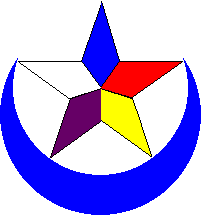 Ratana
Celebrates 2002 Ratana
Celebrates 2002Story & photographs by Keith Newman 2002 (C) A Sleeping Giant By Keith Newman, published in the Manawatu Evening Standard, Wednesday January 23, 2002. |
|
 Several thousand people descended on a tiny village between Manawatu and Rangitikei over the days of January 23-25, 2002 to celebrate the life and work of prophet, faith healer and political leader T. W. Ratana.
Also there for the sports, music and official celebrations were ordinary New Zealanders of all racial and religious persuasions, along with members of the Morehu Youth Movement. Welcoming visitors were the seven Ratana brass bands in their brightly coloured uniforms. The 60,000 strong religious organisation has been through some significant changes in the past decade, with the death of two presidents. Some says the political influence of the movement which once held all four Maori seats, is now negligible but in truth it is a sleeping giant. Why else would the nation's political leaders insist on being at this small village 15 kms south of Wanganui year after year?
In the past there's rarely been any question about Ratana political allegiance since an historic alliance was struck on 22 April 1936 between T. W. Ratana and then prime minister Michael (Mickey) Joseph Savage. Ratana placed four objects on the table: a potato, a gold watch, a greenstone tiki and a huia feather. He explained the potato was the ordinary Maori needing his land because "a potato cannot grow without soil". The watch was broken representing the broken machinery of Maori land law. The tiki represented Maori mana and the huia feather was a sign of chieftainship, which Savage could wear if he were to take on the resolution of these issues so important to the Maori. That year Ratana declared himself and his family to be Labour Party members. Ratana candidates held three out of the Maori four seats by 1938, and the fourth was captured in 1943. These seats were held firmly until the 1963 elections when the Eastern Maori seat was lost. Northern Maori was lost in 1980 and Western and Southern Maori seats held by Koro Wetere and Whetu Tirakatene-Sullivan respectively moved from Ratana grasp in 1996.
His stance is similar to that taken by T W Ratana's youngest son Raniera who was elected at Easter 1994 and announced in 1996 that he would no longer favour any political party. Mr Mason took over the role of president shortly after the death of Raniera in October 1998. Mr Mason says there's always someone approaching the Ratana movement with their political agenda. "You don't have to pick a party or have your own party. There are those who say we should have our own Maori political party but I'm sure Mr Ratana would never split things up between Maori and other races. You have to be part and parcel of something that involves all people." All the canoes together And it is the spiritual side of the Ratana movement which most concerns Mr Mason, and which was the primary concern for its founder before he took up political campaigning. His ministry, spanning the period between the two world wars, began in a fashion reminiscent of some of the more colourful stories from the Bible, with a vision and a period of divine teaching.
He saw a large cloud moving toward him with a brilliant light inside when a reassuring voice spoke to him saying: "Fear not, I am the Holy Ghost. I have travelled around the world to find the people upon whom I can stand. I have come back to Aotearoa to choose you, the Maori people. Repent! Cleanse yourself and your family as white as snow, as sinless as the wood pigeon." The message continued, "Ratana, I appoint you as the mouthpiece of God for the multitude of this land. Unite the Maori people, turning them to Jehovah of the Thousands, for this his compassion to all of you." Spiritual healing ministry During his healing ministry Ratana spoke of faith in a greater spiritual force than oneself. He stressed the importance of individual destiny, saying that humanity was in a constant state of development or becoming. He once said: "in one of my hands is the Bible; in the other the Treaty of Waitangi. If the spiritual side is attended to, all will be well on the physical side." He helped unite previously warring tribes across the country under the banner of Maori self-determination and faith in one God. He claimed for his people the right to full participation in the affairs of the nation and a full Maori identity. He revived the Maori language giving a sense of self -respect to a people ravaged by disease, and discouraged by racism and displacement from their land. The traditional Christian churches at first embraced Ratana but when Maori began leaving their congregations they closed ranks and condemned him as apostate. Even with today's spirit of tolerance there are endless rumours about the man and his ministry and an underlying impression that he was a cult leader who lost the plot. Third generation prophecy He claimed that in the third generation a people empowered by the Wairua Tapu (Holy Spirit) would arise and continue to spread the message of unity, first to their own people, then the Pakeha and on to the world. There is much talk about this prophecy concerning the third generation, which would effectively include many middle aged and young people within the movement today. "What is meant by that is they would have more opportunity and understanding than our ancestors. There were a lot of things that he said at the time the elders couldn't quite grasp," says Mr Mason. He says the main task of the movement's founder was to take Maori away from tohunga, belief in the many gods of the old Maori religions and the attendant superstitions and show them there was only one God, Jehovah. "He achieved that but he also said he could see a day that they would go back. His call to the third generation is to make sure the people don't go back. However right now a lot of our people are going back to the old ways, which is against his teachings. We even have our own people now saying there is a Maori god and a Pakeha god. We don't believe that. There is one God." Mr Mason recalls a meeting between himself and several other Maori spiritual leaders concerned that the young people were going back to the old Maori religions and being told by some of these people that the gods of the European came in with them on the boat whereas the Maori gods were here all the time. "That's not good. We couldn't stand that." Concern about old ways Mrs Hura said her father made the Ratana marae unique without all the carvings and protocol. 'My father loved the Bible, he loved saying the Lord's Prayer; he loved Jesus. But the old Maoris misused the Bible, so he taught from it although he didn't show it. After all, the old tohunga could recite chapters of it - but they abused it." She said the some people abused the name Jesus Christ, and her father did not want the Maori people doing the same. Until recently Ratana Pa and the teachings of its founder have been kept closely guarded despite accurate records being kept by a succession of secretaries and pamphlets printed on the townships own printing press. There's been fear of misinterpretation by the media and others, particularly since the mainstream church abandoned Ratana in the mid 1920s and refused to marry, bury or baptise his followers, forcing T W Ratana to form his own church. To the young, the Ratana church still offers an important link with the past and hope for the future. Despite having to sit through church services and long speeches in a language they still struggle with, many young Maori believe firmly they are somehow benefactors of Ratana's legacy and that the true nature of the movement is yet to be revealed. The once closed book is opening now for those who are keen to find out about the man and his mission. "We have to or we'll have a problem. There's a bit more understanding now among the younger people who seem like they want to listen." The numbers who attend the celebrations are getting bigger every year says Mr Mason. "I don't want to push it on to them but I do wish the younger people would take a bit more interest in the spiritual aspect." The most important thing, he says, is that the Ratana faithful "be seen as brothers and sisters of all the people in New Zealand. I don't like people saying this is a Maori movement. That's not how the founder wanted it - it is for all people and all races and creeds."
|
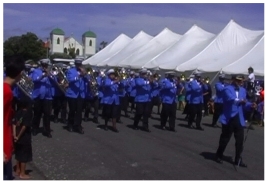 Attending
the annual pilgrimage to Ratana Pa were regular guest Prime
Minister Helen Clark, opposition leader Bill English was there for the
first time,
senior people from other political parties, religious leaders and key
people from Maoridom including Maori Queen Dame Te Atiarangikaahu.
Attending
the annual pilgrimage to Ratana Pa were regular guest Prime
Minister Helen Clark, opposition leader Bill English was there for the
first time,
senior people from other political parties, religious leaders and key
people from Maoridom including Maori Queen Dame Te Atiarangikaahu.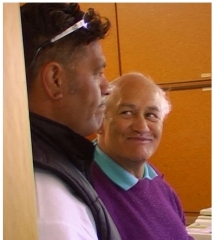 The
movement's current tumuaki or president, Harry Mason, the grandson of church
founder Tahupotiki Wiremu Ratana, says most of the VIPs will turn up on
Thursday January 24 to korero (talk) on the marae with himself, elders and
committee members. "They can sit down with us and talk about anything
they like."
The
movement's current tumuaki or president, Harry Mason, the grandson of church
founder Tahupotiki Wiremu Ratana, says most of the VIPs will turn up on
Thursday January 24 to korero (talk) on the marae with himself, elders and
committee members. "They can sit down with us and talk about anything
they like."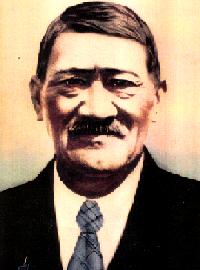 Mr
Mason, 68 and a unionist most of his life, says he has always been a
Labour backer and conscious of the strong ties in the past. "That's
still how I see it myself but when you talk from the movement's point of
view I think it's up to people themselves."
Mr
Mason, 68 and a unionist most of his life, says he has always been a
Labour backer and conscious of the strong ties in the past. "That's
still how I see it myself but when you talk from the movement's point of
view I think it's up to people themselves."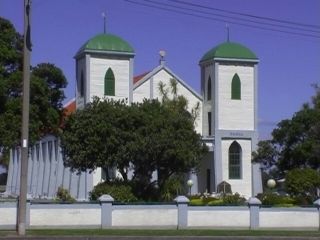 'Bill'
Ratana a hard drinking, hard living horse riding bookie, ploughman and
wheat stacker was standing on the veranda of his family home on Friday Nov
8th, 1918 three days before the end of World War 1, when he felt as though
he was being consumed by fire.
'Bill'
Ratana a hard drinking, hard living horse riding bookie, ploughman and
wheat stacker was standing on the veranda of his family home on Friday Nov
8th, 1918 three days before the end of World War 1, when he felt as though
he was being consumed by fire.